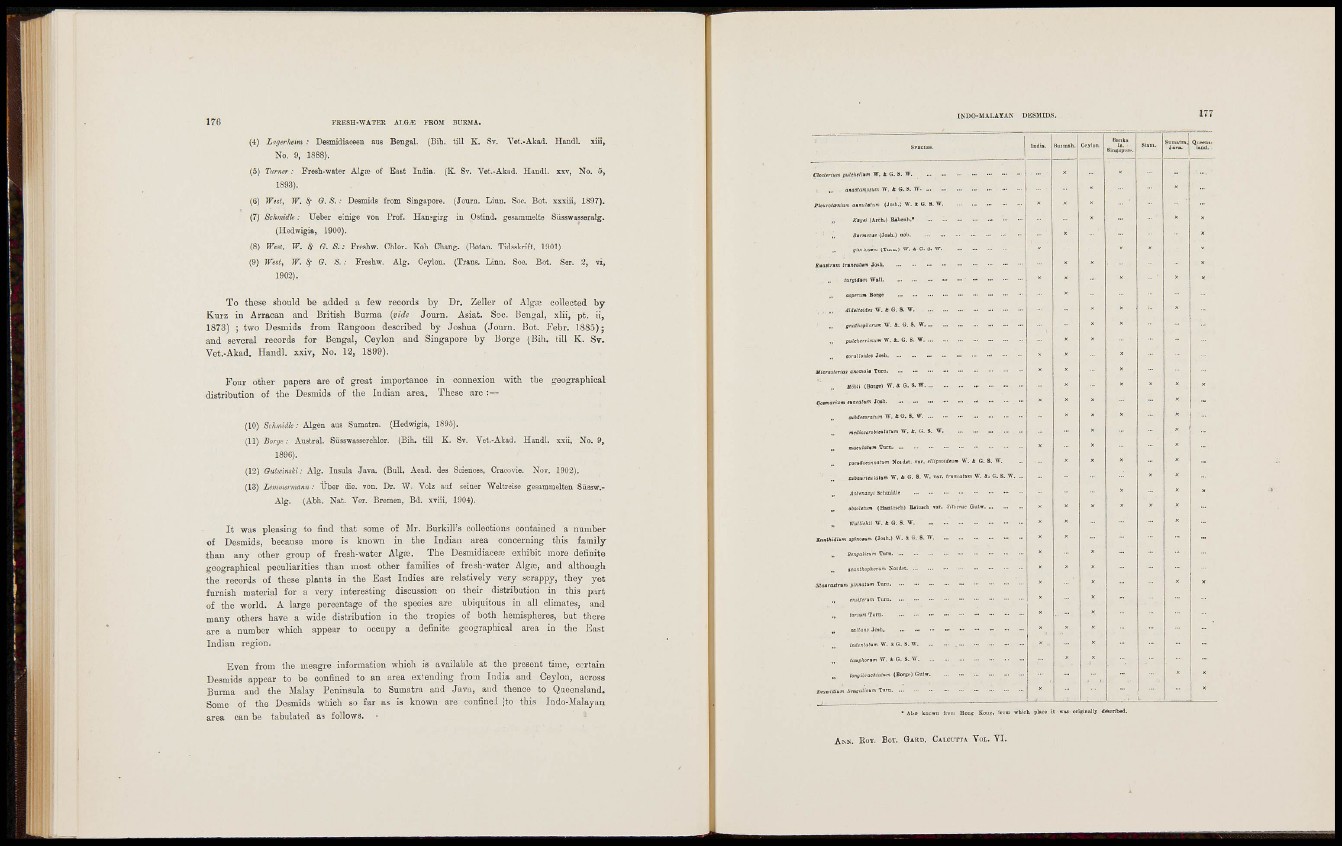
176 FRESH-WATER ALG^ FBOM BURMA.
(4) Ligerhem : Desmidiaceeu aus Bengal. (Bih. till K. Sv. Yel.-Akad. Handl. xiii.
No. 9, 1888).
(5) Turner: Fresh-water Alg® of East India. (K Sv. Vet.-Akad. Haudl. xsv, No. 5,
1S93).
(G) West, W. Q. S..- DeBmiils from Singapore. (Jouru. Liun. Soc. Bot. xsxiii, 1897).
(7) Schmidk: Ueber einige von Prof. Han?girg in Ostiad. gesammelts Siisswasseralg.
(Hedwigia, 1900).
(8) Wen, W. G. S.: Freshw. Chlor. Koh Chang. (Botan. Tidsskrift, 1901).
(9) West, W. ^ G. S.: Freshw. Alg. Ceylon. (Trans. Linn. Soo. Bot. Ser. 2, vi,
1902).
To these should be added a few records by Dr. Zellei- of Algaj collected by
Kurz io Arracan and British Burma {vide Journ. Asiat. Soc. Bengal, xlii, pt. ii,
1873) ; two Desmids from Rangoou described by Joshua (Journ. Bot. Febr. 1885);
and several records for Bengal, Ceylon and Singapore by Borge (Bill, till K. Sv.
Vet.-Akad. Haadl. ssiv, No. 12, 1899).
Four other papers are of great importance in conuesion with the
distribution of the Desmids of the Indian area. These are
•ical
(10) Schnidk: Algen aus Sumatra. (Hedwigia, 1895).
{U) Borge: Austral. Susswasserchlor. (Bih. till K. Sv. Vet.-Akad. Handl. ssii, No.
(12) Quiicimki: Alg. Insula Java. (Bull. Aoad.
(13) Lemmevniattn: Über die. von. Dr. W. Volz auf seiof
Alg. (Abh. Nafc. Yer. Bremen, Bd. xTÜi, 1904).
, Craeovie. Nov. 1902),
Weltreise geiammelten Siissw.-
I t was pleasing to find that some of Mr. Burkill's colloctions contained a number
of De.smids, because more is known in the Indian area concerning this family
than any other group of fresh-water Alg®. The Desmidiacere exhibit more definite
geographical peculiarities t t a n most other families of fresh-water Algce, and although
the records of these plants in the East Indies are relatively very scrappy, they yet
fui'nish material for a very interesting discussion on their distribution in this part
of tlie world. A large percentage of the species are ubiquitous in all climates, and
many others have a wide distribution in tlie tropics of both hemispheres, but there
are a number which appear to occupy a definite geograpliical area in the East
Indian region.
Even from the meagre information which is available at tlie present time, certain
Desmids appear to be confined to an area expending from India and Ceylon, across
Burma and the Malay Peninsula to Sumatra and Java, and thence to Queensland.
Some of the Desmids wtiich so far as is known are confined [to this Indo-Malayaa
area can be tabulated as fo]lows. •
IKDO-MALATAN DESMIDS.
aeslerium puleMltm W. t G. B. W.
W. 4 G, S.
Ka!„i (ireh.)
5>™f;i»i (Jo»b.) aob.
plorioswji (Turn,I W, » G
.ailr.r, c^italum Jo.b
lun>iW:
,. a$ptrum Bow
., aidwroM« W. t G. S. W.
INATHEPHON^M T, G. 8. W
»luni.
:Mt-jm Soidil. »
„ /tsiiiBSiii Schmiilo
oSsol»!""' <Haiitjscli) BiiuKli T!
„ Sensalieyrr. Tum. .-
aeanlhcphOTiim Xoidst
loniii-j-artiol"»» (BoiUfl Gutw.
H it wiu orlgioallr «escribed.
ANK. EUY. Bor. GARD. CAI.CITTA TOL. YI.